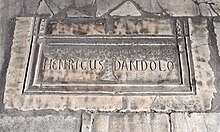Enrico Dandolo
[5] Dandolo's first important political roles took place during the crisis years of 1171 and 1172, which were a tumultuous period between the Byzantine and Venetian states.
[6] Popular Venetian anger with the attack forced Doge Vitale II Michiel to gather a retaliatory expedition, which included Dandolo.
[8][9] The succeeding doge, Sebastiano Ziani, sought to form alliances with enemies of the Byzantine empire so that it would feel pressured into coming to terms with Venice.
[11] Despite Dandolo's failure to meet with William II, his constant participation in these envoys shows his value and importance within the ducal court, qualities which no doubt contributed to his election as doge in 1192.
[14] In 1184, Dandolo, serving again as a ducal legate along with Pietro Ziani and Domenico Sanudo, returned to Constantinople to negotiate the restoration of the Venetian quarter with Andronicus.
The commonly given birth year of c. 1107 is based on the account of Marino Sanuto the Younger (1466 – 1536) three centuries later, who stated that Dandolo was eighty-five when he assumed the throne.
[22] In 1193, Dandolo commanded an attack on the nearby city of Zara, which for years had troubled Venice and threatened its control over the Dalmatian Coast.
[23] Dandolo seemed to have always supported Venice's reinstating power over the city, since he had contributed money to doge Orio Mastropiero's 1187 military attempt to regain control there.
[30] Dandolo arranged meetings for them with the ducal court, in which the council calculated the expenses necessary for this voyage, which would be the largest project in Venetian history.
[34] When more Crusaders began to arrive that June, the urgency for this money increased as many Venetians, whose business relied on this reimbursement, were being driven closer to financial ruin.
[35] When the due date for payment arrived, Dandolo ordered the Crusaders, who were staying on the nearby Lido, to collectively pay 85,000 marks.
[35] Instead of ejecting them, Dandolo decided to lend this amount from the Venetian state, provided that it was paid back in the form of the spoils of the Crusade.
[38] Confusion ensued, as Pope Innocent forbade the Crusade from settling this dispute unrelated to their original religious agenda, especially since the land was controlled by King Emeric of Hungary, who had himself taken the cross some while ago.
During the looting, Dandolo had many items of value sent back to Venice, including the four Horses of St. Mark that decorate the Venetian cathedral to this day.
[44] When Constantinople fell, Dandolo understood that he needed to quickly restore stability to the empire to avoid disorder that could threaten Venice.
The real tomb was allegedly destroyed; various legends attribute this destruction to the times of the Byzantine reconquest of the city or shortly after the Ottoman conquest of Constantinople in 1453 and subsequent conversion of Hagia Sophia into a mosque.
TRT's georadar images indicate the presence of a human skeleton whose head is approximately 50 centimeters below the cenotaph in a sitting position facing towards Jerusalem.
[56] According to Thomas F. Madden's study, Dandolo had cortical blindness as a result of a severe blow to the back of the head received sometime between 1174 and 1176.
[57] Documents show Dandolo's signature being fully legible in 1174 but sprawling across the paper in 1176, suggesting that his sight deteriorated over time.
Geoffrey de Villehardouin, whom Dandolo accompanied on the Fourth Crusade, wrote that "although his eyes appeared normal, he could not see a hand in front of his face, having lost his sight after a head wound".
[58] This piece of primary evidence seems to support Madden's theory that Dandolo's blindness was cortical, since his eyes appeared to be unharmed.


